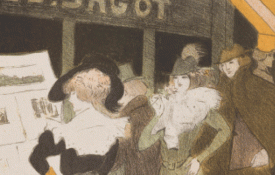Moonshot: (1) The launching of a spacecraft to the moon; (2) an ambitious and expensive goal, widely expected to have great significance.
Loonshot: A neglected project, widely dismissed, its champion written off as unhinged.
One winter morning in 2003, I drove to the Beth Israel Deaconess Medical Center in Boston to meet a patient named Alex. Alex was 33, with the strong, graceful build of an athlete. He had been diagnosed with an aggressive form of cancer called Kaposi’s sarcoma. Six regimens of chemotherapy had not stopped his disease. His prognosis was poor. A handful of scientists and I had spent two years preparing for this moment. Alex was scheduled to be the first patient to receive our new drug for treating cancer.
When I entered his room, Alex was lying in bed, attached to an IV drip, speaking softly to a nurse. A yellowish liquid, our drug, fed slowly into his arm. The physician had just left. Then the nurse, who had been writing up notes in the corner, closed her folder, waved, and left. Alex turned to me with a gentle smile and quizzical look. The frenzy of activity to get to this day—licensing discussions, financings, laboratory studies, safety experiments, manufacturing checks, FDA filings, protocol drafting, and years of research—melted away. Alex’s eyes asked the only thing that mattered: would the yellowish liquid save his life?
Physicians see this look all the time. I didn’t.
I pulled up a chair. We talked for nearly two hours, as the drug dripped into Alex’s arm. Restaurants, sports, the best cycling paths in Boston. Toward the end, after a pause, Alex asked me what would be next, if our drug didn’t work. I stumbled through some non-answer. But we both knew. Despite tens of billions of dollars spent every year on research by national labs and large research companies, sarcoma treatment hadn’t changed in decades. Our drug was a last resort.
Two years later, I found myself pulling up a chair next to another bed, in a different hospital. My father had developed an aggressive type of leukemia. One older physician told me, sadly, that all he could offer was the same chemotherapy he had prescribed as a resident forty years earlier. Second, third, and fourth opinions and dozens of desperate phone calls confirmed what he said. No new drugs. Not even any promising clinical trials.
There are some technical reasons why cancer drug development is so difficult. So many things have broken down inside a cancer cell by the time it starts proliferating that there’s no easy fix. Laboratory models are notoriously bad at predicting results in patients, which leads to high failure rates. Clinical trials take years to conduct and can cost hundreds of millions of dollars. All these points are true.
But there’s more.

Loonshots has been recommended by Bill Gates, Daniel Kahneman, Ed Catmull, General Stanley McChrystal, Malcolm Gladwell, Adam Grant, Susan Cain, Daniel Pink, and Tim Ferriss.
MILLER’S PIRANHA
“They looked at me like I was a lunatic,” Richard Miller told me.
Miller, an affable oncologist in his sixties, was explaining to me the reactions of research teams at large pharma companies to his suggestion of treating cancer patients with a new drug he had been working on. It was a chemical designed originally just for laboratory use, for experiments—a tool, like bleach.
Most drugs work by gently attaching themselves to the overactive proteins inside cells that trigger disease. Those proteins act like an army of hypercharged robots, causing cells to go haywire. The cells may start multiplying out of control, like in cancer. Or they may attack the body’s own tissues, like in severe arthritis. By attaching to the overactive proteins, drugs dial down their activity, quieting the cells, restoring order in the body.
The most important breakthroughs rarely follow blaring trumpets and a red carpet, with central authorities offering overflowing pots of tools and money. They are surprisingly fragile. They pass through long dark tunnels of skepticism and uncertainty, crushed or neglected, their champions often dismissed as crazy—or just plain dismissed, like Miller.
Miller’s drug, however, didn’t gently attach; it was a piranha (irreversible binder, to chemists). It grabbed hold and never let go. The problem with piranhas is that you can’t wash them out of your system if something goes wrong. If they latch on to the wrong protein, for example, they can cause serious, even fatal, toxicities. You don’t give piranhas to patients.
Miller was the CEO of a struggling biotech company. Its first project, developed a decade before Miller’s new drug, hadn’t panned out. The company’s stock price had fallen below a dollar, and it received a delisting notice from Nasdaq, meaning that it would soon be banished from the market for serious companies and transferred to the purgatory of flaky has-beens.
I asked Miller why he persisted with the piranha in that precarious state and despite so many rejections, even ridicule. Miller said he understood all the arguments against his drug. But there was a flip side: the drug was so strong that he could give a very low dose. Miller also served part-time as a physician at Stanford University. He explained that he knew his patients. Many had only months to live, were desperately looking for options, and understood the risks. The potential, in this context, justified the risk.
“There’s a quote from Francis Crick that I love,” Miller said. Crick was awarded the Nobel Prize for discovering, along with James Watson, the double-helix structure of DNA. “When asked what it takes to win a Nobel Prize, Crick said, ‘Oh it’s very simple. My secret had been I know what to ignore.’”
Miller shared the early laboratory results from his piranha with a handful of physicians, who agreed to proceed with a clinical trial in patients with advanced leukemias. But Miller’s investors were not convinced. (Miller: “To this day, if you ask them [how the drug works], they wouldn’t know.”) He lost a boardroom battle and resigned as CEO.
The trial, however, continued. Not long after Miller left, early results came back. They were encouraging. The company began a much larger, pivotal study. Half the patients would receive standard therapy, half the new drug. In January 2014, the physicians monitoring that study, which enrolled nearly four hundred patients, recommended that the trial be stopped. The results were so spectacular—a nearly ten times higher response rate in patients who received Miller’s drug, called ibrutinib, than in patients who received standard therapy—that denying patients in the control group access to ibrutinib was considered unethical.
The FDA approved the drug shortly afterward. A few months later, Miller’s company, called Pharmacyclics, was acquired by one of those large pharma companies that had ridiculed the idea.
The price: $21 billion.
Miller’s piranha was a classic loonshot. The most important breakthroughs rarely follow blaring trumpets and a red carpet, with central authorities offering overflowing pots of tools and money. They are surprisingly fragile. They pass through long dark tunnels of skepticism and uncertainty, crushed or neglected, their champions often dismissed as crazy—or just plain dismissed, like Miller.
Scientist and piranha
Drugs that save lives, like technologies that transform industries, often begin with lone inventors championing crazy ideas. But large groups of people are needed to translate those ideas into products that work. When teams with the means to develop those ideas reject them, as every large research organization rejected Miller’s piranha, those breakthroughs remain buried inside labs or trapped underneath the rubble of failed companies.
Miller just barely saved his idea. Most loonshots never get the chance.
There’s something at the core of how large groups behave that we just don’t understand, despite the mountains of mind-numbing print written on the subject. Every year, glossy magazines celebrate the winning cultures of innovative teams. Covers show smiling employees raising gleaming new products like runners raising the Olympic torch. Leaders reveal their secrets. And then, so often, those companies crash and burn. The people are the same; the culture is the same; yet seemingly overnight, they turn. Why?
Articles and books on culture have always felt squishy to me. I hear culture, I think yogurt. For example, one popular book, typical of the genre, identifies a handful of top companies based on their stock price performance and then extracts from their similarities squishy lessons on creating a winning culture. One of those companies happens to be Amgen, a biotech company I know well. Among the Amgen lessons extracted: “By embracing the myriad of possible dangers, they put themselves in a superior position.”
The real story with Amgen is that after a couple of years in business, the company was nearly bankrupt, all its initial projects (including a chicken growth hormone and pig vaccines) had failed, and time was running out on a final project, a drug to stimulate the growth of red blood cells. A handful of companies were pursuing the same goal. Amgen got to the finish line just ahead of its competitors. Much of that was due to a University of Chicago professor named Eugene Goldwasser. Goldwasser had worked on the problem for twenty years and held the key to winning the race: an eight-milligram vial of purified protein, painstakingly extracted from 2,550 liters of human urine. The purified protein contained the code to making the drug. He decided to give that vial to Amgen rather than its main competitor, Biogen. Biogen’s CEO had refused to pick up the check for dinner one night.
The drug, called erythropoietin, or epo for short, turned out to be far, far more successful than anyone, including Amgen, imagined—eventually bringing in $10 billion a year. Amgen had won the drug-discovery lottery. Once it had the drug, Amgen sued everyone else in the business (including its partner, Johnson & Johnson, which had saved Amgen when it was struggling) to stop them from competing. For the next fifteen years, Amgen was unable to repeat its drug-discovery success. Its poor research output, as measured by number of patents awarded, was noted by the culture-analyzing book, which concluded that being “innovative doesn’t seem to matter very much.”
Amgen may not have had good research, but it did have good lawyers. It won every lawsuit, and its competitors gave up. Among insiders, the company was called “a law firm with a drug.”
Useful lessons from Amgen’s story include picking up the check for dinner and hiring good lawyers. But otherwise, extracting culture tips, after the fact, from its terrific stock price performance is like asking the guy who just won the Lotto to describe the socks he was wearing when he bought the winning ticket.
My resistance to after-the-fact analyses of culture comes from being trained as a physicist. In physics, you identify clues that reveal fundamental truths. You build models and see if they can explain the world around you. And that’s what we will do in this book. We will see why structure may matter more than culture.
* * *
After a few months of treatment at Beth Israel, Alex recovered. He is still alive today, as I write this. My father did not recover. No treatment I could find, none of the desperate phone calls, none of the expert friends and colleagues, none of the work I’d done, nothing made any difference. He died a few months after he was diagnosed, but for many years after, I felt I was still fighting that battle, that if I worked hard enough, I could find something for what he had, and it would matter. That I would stop feeling I had let him down. In a recurring dream, I hand the nurse by his bed a vial. She plugs it into his IV. Disease disappears.
Dozens of promising drug candidates for treating my father’s condition were buried then. They remain buried today. To liberate those buried drugs and other valuable products and technologies, we need to begin by understanding why good teams, with the best intentions and excellent people, kill great ideas.
WHEN TEAMS TURN
In the 1970s, Nokia was an industrial conglomerate famous mostly for its rubber boots and toilet paper. Over the next two decades, it would pioneer the first cellular network, the first car phone, the first all-network analog phone, and the first wildly successful GSM phone. By the early 2000s, it was selling half the smartphones on the planet. It became, briefly, the most valuable company in Europe. A BusinessWeek cover story declared, “Nokia has become synonymous with success.” Fortune revealed Nokia’s secret: it was “the least hierarchical big company in the world.” The CEO explained that the key was the culture: “You are allowed to have a bit of fun, to think unlike the norm . . . to make a mistake.”
In 2004, a handful of excited Nokia engineers created a new kind of phone: internet-ready, with a big color touchscreen display and a high-resolution camera. They proposed another crazy idea to go along with the phone: an online app store. The leadership team—the same widely admired, cover-story leadership team—shot down both projects. Three years later, the engineers saw their crazy ideas materialize on a stage in San Francisco. Steve Jobs unveiled the iPhone. Five years later, Nokia was irrelevant. It sold its mobile business in 2013. Between its mobile peak and exit, Nokia’s value dropped by roughly a quarter trillion dollars.
A wildly innovative team had turned.
In medical research, for decades, Merck was the most revered company. From 1987 to 1993, it placed first in Fortune’s annual most-admired-company survey, a seven-year streak not matched until Apple achieved it in 2014. Merck launched the first cholesterol-lowering drug. It developed the first drug for river blindness, and then donated that drug at no cost to many countries in Africa and Latin America. Over the next ten years, however, Merck missed nearly every important breakthrough in drug discovery. It overlooked not only genetically engineered drugs, which transformed the industry (more about that later), but also drugs for cancer, autoimmune diseases, and mental disorders, the three biggest success stories of the 1990s and early 2000s.
In every creative field, we see legendary teams suddenly, and mysteriously, turn. In his wonderful memoir of his time at Pixar, Ed Catmull writes about Disney:
After The Lion King was released in 1994, eventually grossing $952 million worldwide, the studio began its slow decline. It was hard, at first, to deduce why—there had been some leadership changes, yet the bulk of the people were still there, and they still had the talent and the desire to do great work.
Nevertheless, the drought that was beginning then would last for the next sixteen years: From 1994 to 2010, not a single Disney animated film would open at number one at the box office. . . .I felt an urgency to understand the hidden factors that were behind it.
Let’s talk about those hidden factors.
MORE IS DIFFERENT
The pattern of sudden changes in the behavior of teams and companies—of the same people suddenly behaving in very different ways—is a mystery in business and social science. Entrepreneurs, for example, often say that big companies fail because big-corporate types are conservative and risk-averse. The most exciting ideas come from small companies, because—we tell ourselves—we are the truly passionate risk-takers. But put that big-corporate type in a startup, and the tie will come off and he’ll be pounding the table supporting some wild idea. The same person can act like a project-killing conservative in one context and a flag-waving entrepreneur in another.
The change in behavior may be a mystery in business, but a similar pattern is the essence of a strange quirk of matter called a phase transition. Imagine a large bathtub filled with water. Hit the surface with a hammer: a splash, and the hammer slips through the liquid. Then lower the temperature until the water freezes. Strike again, and the surface shatters.
The same molecule behaves like a liquid in one context and a rigid solid in another.
Why? How do molecules “know” to suddenly change their behavior? To put it another way, which brings us even closer to the mystery of our supposedly risk-averse, big-corporate type: If we drop a molecule of water onto a block of ice, what happens? It freezes. If we drop that same molecule into a pool of water, what happens? It slushes around with all the other molecules. How can we explain this?
The physicist and Nobel laureate Phil Anderson once captured the core idea underlying the answers to these questions with the phrase more is different: “The whole becomes not only more than but very different from the sum of its parts.” He was describing not only the flow of liquids and the rigidity of solids but even more exotic behaviors of electrons in metals (for which he won his Nobel Prize). There’s no way to analyze just one molecule of water, or one electron in a metal, and explain any of these collective behaviors. The behaviors are something new: phases of matter.
I will show you that the same holds true for teams and companies. There’s no way to analyze the behavior of any individual and explain the group. Being good at nurturing loonshots is a phase of human organization, in the same way that being liquid is a phase of matter. Being good at developing franchises (like movie sequels) is a different phase of organization, in the same way that being solid is a different phase of matter.
When we understand those phases of organization, we will begin to understand not only why teams suddenly turn, but also how to control that transition, just as temperature controls the freezing of water.
The basic idea is simple. Everything you need to know is in that bathtub.
WHEN SYSTEMS SNAP
The molecules of a liquid roam all over. Think of the water molecules in the tub as a platoon of cadets running randomly around a practice field. When the temperature drops below freezing, it’s as if a drill sergeant blew a whistle and the cadets suddenly snapped into formation. The rigid order of the solid repels the hammer. The chaotic disorder of the liquid lets it slip through.
Systems snap when the tide turns in a microscopic tug-of-war. Binding forces try to lock water molecules into rigid formation. Entropy, the tendency of systems to become more disordered, encourages those molecules to roam. As temperature decreases, binding forces get stronger and entropy forces get weaker.
When the strengths of those two forces cross, the system snaps. Water freezes.
All phase transitions are the result of two competing forces, like the tug-of-war between binding and entropy in water. When people organize into a team, a company, or any kind of group with a mission, they also create two competing forces—two forms of incentives. We can think of the two competing incentives, loosely, as stake and rank.
As structure changes, one grows stronger and the other grows weaker. When groups are small, for example, everyone’s stake in the outcome of the group project is high. At a small biotech, if the drug works everyone will be a hero and a millionaire. If it fails, everyone will be looking for a job. The perks of rank—job titles or the increase in salary from being promoted—are small compared to those high stakes.
As teams and companies grow larger, the stakes in outcome decrease while the perks of rank increase. When the two cross, the system snaps. Incentives begin encouraging behavior no one wants. Those same groups—with the same people—begin rejecting loonshots.
The bad news is that phase transitions are inevitable. All liquids freeze. The good news is that understanding the forces allows us to manage the transition. Water freezes at 32 degrees Fahrenheit. On snowy days, we toss salt on our sidewalks to lower the temperature at which that water freezes. We want the snow to melt rather than harden into ice. We’d rather wet our shoe in a puddle than slip and spend a week in the hospital.
We use the same principle to engineer better materials. Adding a small amount of carbon to iron creates a much stronger material: steel. Adding nickel to steel creates some of the strongest alloys we know: the steels used inside jet engines and nuclear reactors.
We will see how to apply a similar principle to engineer more innovative organizations. We will identify the small changes in structure, rather than culture, that can transform a rigid team.
Leaders spend so much time preaching innovation. But one desperate molecule can’t prevent ice from crystallizing around it as the temperature drops. Small changes in structure, however, can melt steel.















































